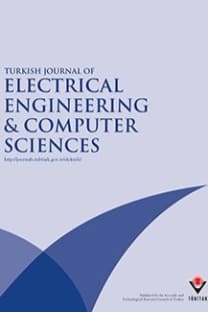A novel efficient model for the power flow analysis of power systems
Power flow calculation, linear modeling, steady state power system analysis
A novel efficient model for the power flow analysis of power systems
___
- H. Kim, N. Samann, D. Shin, B. Ko, G. Jang, J. Cha, “A new concept of power flow analysis”, Journal of Electrical Engineering & Technology, Vol. 2, pp. 312–319, 2007.
- P.J. Lagace, M.H. Vuong, I. Kamwa, “Improving power flow convergence by Newton Raphson with a Levenberg- Marquardt method”, IEEE Power Engineering Society General Meeting, pp. 1–6, 2008.
- N.D. Duc, H.B. Gooi, “Using quadratic programming for power flow calculations”, International Power Electronics Conference General Meeting, pp. 1106–1110, 2010.
- Y. Yude, Q. Zhijun, “Vectorial power flow calculation based on nonlinear programming”, IEEE Power Engineering Society General Meeting, pp. 1–6, 2008.
- R. Bo, F. Li, “Vectorial power flow calculation based on nonlinear programming”, IEEE Power and Energy Society General Meeting - Conversion and Delivery of Electrical Energy in the 21st Century, pp. 1–6, 2008.
- P.R. Bijwe, B. Abhijith, G.K.V. Raju, “Robust three phase fast decoupled power flow”, IEEE/PES Power Systems Conference Exposition, pp. 1–5, 2009.
- P. Acharjee, S.K. Goswami, “Chaotic particle swarm optimization based reliable algorithm to overcome the limita- tions of conventional power flow methods”, IEEE/PES Power Systems Conference Exposition, pp. 1–7, 2009.
- R. Rarick, D. Simon, F.E. Villaseca, B. Vyakaranam, “Biogeography-based optimization and the solution of the power flow problem”, IEEE International Conference on Systems, Man, and Cybernetics, pp. 1003–1008, 2009.
- Y. Yao, L. Liu, Y. Wang, H. Zhao, “An improved voltage start for Newton power flow in rectangular form”, International Conference on Power Electronics and Intelligent Transportation System, pp. 190–193, 2009.
- Y. Yao, J. Shan, D. Wang, L. Liu, “An improved Newton power flow in rectangular form for systems with small impedance branches”, International Conference on Power Electronics and Intelligent Transportation Systems, pp. 10–14, 2009.
- Z. Xu, Q. Jia, L. Liu, “The approximate expression of power flow Jacobian matrix and analysis”, International Conference on Sustainable Power Generation and Supply, pp. 1–4, 2009.
- W. Li, X. Han, B. Zhang, “A comparison of power flow by different ordering schemes”, International Conference on Electric Utility Deregulation and Restructuring and Power Technologies, pp. 742–745, 2011.
- Y. Yao, Y. Tan, M. Li, D. Wang, F. Zhang, “Study on methods for solving the divergence of power flow with small impedance branches”, International Conference on Sustainable Power Generation and Supply, pp. 1–7, 2009.
- F. Milano, “Continuous Newton’s method for power flow analysis”, IEEE Transactions on Power Systems, Vol. 24, pp. 50–57, 2009.
- J. Byun, A. Ravindran, A. Mukherjee, B. Joshi, D. Chassin, “Accelerating the Gauss-Seidel power flow solver on a high performance reconfigurable computer”, IEEE Symposium on Field Programmable Custom Computing Machines, pp. 227–230, 2009.
- H. Da˘g, E.F. Yetkin, “A spectral divide and conquer method based pre-conditioner design for power flow analysis”, International Conference on Power System Technology, pp. 1–6, 2010.
- L. Ao, B. Cheng, F. Li, “Research of power flow parallel computing based on MPI and P-Q decomposition method”, International Conference on Electrical and Control Engineering, pp. 2925–2928, 2010.
- D.P. Chassin, P.R. Armstrong, D.G. Chavarr´ıa-Miranda, R.T. Guttromson, “Gauss-Seidel accelerated: implement- ing flow solvers on field programmable gate arrays”, IEEE Power Engineering Society General Meeting, 2006.
- N. Garcia, “Parallel power flow solutions using a bi-conjugate gradient algorithm and a Newton method: a GPU- based approach”, IEEE Power Engineering Society General Meeting, pp. 1–4, 2010.
- J. Singh, I. Aruni, “Accelerating power flow studies on graphics processing unit”, Annual IEEE Indian Conference, pp. 1–5, 2010.
- Y. Zhang, H. Chiang, “Fast Newton-FGMRES solver for large-scale power flow study”, IEEE Transactions on Power Systems, Vol. 25, pp. 769–776, 2010.
- Y. Chen, C. Shen, “A Jacobian-free Newton-GMRES(m) method with adaptive pre-conditioner and its application for power flow calculations”, IEEE Transactions on Power Systems, Vol. 21, pp. 1096–1103, 2006.
- R. Idema, D.J.P. Lahaye, C. Vuik, L.V.D. Sluis, “Scalable Newton-Krylov solver for large power flow problems” IEEE Transactions on Power Systems, Vol. 27, pp. 390–396, 2012.
- R. Jegatheesan, N.M. Nor, M.F. Romlie, “Newton-Raphson power flow solution employing systematically con- structed Jacobian matrix”, IEEE International Conference on Power and Energy, pp. 180–185, 2008.
- R.S. Maciel, A.P. Feltrin, E. Righeto, “Substitution-Newton-Raphson method for the solution of electric network equations”, IEEE Transmission and Distribution Conference and Exposition: Latin America, pp. 1–6, 2006.
- S. Lu, N. Zhou, N.P. Kumar, N. Samaan, B.B. Chakrabati, “Improved DC power flow method based on empirical knowledge of the system”, IEEE Transmission and Distribution Conference and Exposition, pp. 1–6, 2010.
- P. Yan, A. Sekar, “Study of linear models in steady state load flow analysis of power systems”, IEEE Power Engineering Society Winter Meeting, Vol. 1, pp. 666–671, 2002.
- ISSN: 1300-0632
- Yayın Aralığı: Yılda 6 Sayı
- Yayıncı: TÜBİTAK
A new cascaded multilevel inverter with series and parallel connection ability of DC voltage sources
Ebrahim BABAEI, Saeed Sheermohammadzadeh GOWGANI, Mehran SABAHI
Discrete-time modeling of Hamiltonian systems
Yaprak YALÇIN, Leyla Gören SÜMER, Salman KURTULAN
Design and implementation of IR and laser-based electronic ciphering systems
A new systematic and flexible method for developing hierarchical decision-making models
Ulaş BELDEK, Mehmet Kemal LEBLEBİCİOĞLU
Design of a novel USB crypto bridge device
Asaf Behzat ŞAHİN, Hatice Gonca BULUR
Short-term load forecasting using mixed lazy learning method
Seyed-Masoud BARAKATI, Ali Akbar GHARAVEISI, Seyed Mohammad Reza RAFIEI
